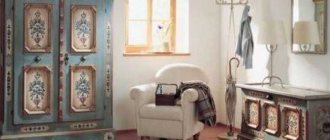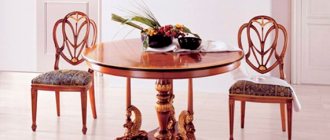44299
Cherry wood has a unique reddish-brown tone that is very similar to mahogany. Therefore, it is often used as a cheap alternative to this expensive material, producing furniture pieces of amazing beauty and level of functionality. But it is important to be able to reveal the beauty of cherries. We invite you to find out how to successfully integrate cherry-colored furniture into your interior, photos and advice from experienced designers.
Shade options
Wood from different types of cherry is used to make furniture. In terms of physical characteristics, they are almost the same; the difference lies in the texture of the material and its shades:
- Bird cherry (cherry). The wood is famous for its beautiful, almost uniform structure. The color varies from pink-brownish to pink-grayish. Sapwood in the form of a narrow strip of yellowish tone.
- American cherry has a beautiful warm hue. The color of the kernel ranges from reddish-brown to deep red. The subcortex is narrow and pink. The peculiarity of the structure is thin core rays and small resin inclusions.
- Masaranduba (Brazilian cherry). The wood is homogeneous, with straight, small grains. Shades depend on the conditions and location of the tree. When freshly cut, the color ranges from pale red to distinct pink. After drying, it darkens, becomes brown-red with a golden or chestnut tint, or burgundy with a violet-silver sheen. The material is highly durable and surpasses oak in hardness. The structure contains rubber resins, thanks to which the wood is resistant to moisture and mold. Despite its high hardness, cherry wood lends itself well to processing.
Physical properties of cherry wood
- The density of cherry wood is 630-650 kg/m3
- The maximum density of cherry wood is about 710 kg/m3.
- Bend strength - 95-97N/mm2
- Compressive strength - 95-98N/mm2
- Cherry wood is susceptible to rot and requires special treatment
- Well polished, easy to saw and sand
- Hardness -31N/mm² (90°), 55N/mm² (0°)
- Radial shrinkage: 5%
- Tangential shrinkage: 8.7%
- Radial swelling: 0.16–0.18%
- Tangential swelling: 0.26–0.30% Tangential swelling: 0.26–0.30%
Furniture materials
Furniture makers highly value cherry wood, classifying it as an elite species. The whimsical texture, soft transitions of shades, and the unique pattern of annual rings create a unique pattern. And thanks to the property of darkening over time, cherry furniture becomes more aristocratic and refined over the years.
Furniture made from solid cherry is rightfully considered exclusive. Wood of a noble shade looks good in an apartment, country house or executive office. Solid wood products are available in different styles, from country to classic. The sets are installed in living rooms, dining rooms, and halls, as they look very respectable. Due to its ease of processing, solid cherry is used to create furniture of the most complex shapes. Disadvantages include exposure to sunlight, temperature changes, humidity, and sensitivity to bacteria.
Alder-colored furniture, photos, features of combination with different styles
Laminated chipboard is a practical alternative to expensive solid wood material. Laminated boards for cherry furniture are available in a variety of colors: from grayish brown to rich red with an orange undertone. Used for the production of headsets of any style. Warm shades go well with other light wood materials. If furniture made of solid cherry is not recommended for installation in the kitchen and bathrooms, then for a set of laminated chipboard there are no such restrictions. Decorative film can withstand high temperatures and high humidity. Pros:
- affordable price;
- imitation of natural wood;
- ease of maintenance and repair.
Flaws:
- susceptibility to chipping;
- impossibility of milling (accordingly, laminated chipboard is not suitable for interior items with smooth angles, bevels, or a relief surface);
- In case of damage, harmful fumes are released.
Furniture made from fine wood fraction (MDF) is resistant to mechanical damage and safe for health, since it does not emit harmful fumes. The plates are plastic, bend well, and are amenable to drilling and cutting tools. Furniture made from MDF is an excellent replacement for solid wood products. Pros:
- similarity to natural material;
- the ability to manufacture items of different configurations;
- affordable price;
- repairable.
Cons: Requires careful maintenance.
Array
laminated chipboard
MDF
How wild cherry blossoms
Wild cherries are found in Eastern Europe, Russia, the Far East, Japan and China. It grows in city parks, squares and alleys. The popularity of wild cherries is associated with the flowering of the plant. Many works of art have been created about the beauty of this phenomenon.
Wild cherry blossoms are described in works of art
There are many varieties of wild cherries. In the European part of Russia, in the Mediterranean countries and Asia, wild cherry has different names - steppe, velvet bushy, pink, bird cherry, bush cherry, dark cherry, forest cherry, etc. This plant reaches 3 m in height. It is frost-resistant and drought-resistant.
Even in the absence of quality care, these trees and shrubs can live up to 30 years. There are some specimens that are 50 years old. Fruiting is abundant only if it grows in open areas. This tree doesn't like shadows.
The crown of the tree is dense. The leaves have an ovoid, oblong shape. The plant can bloom from April to July. The flowering period itself is short - up to 7 days. Fruiting occurs in June-July. The berries are smooth, without plaque, sweet and sour, and in their benefits are not inferior to garden varieties.
The fruits contain a lot of sugars and vitamins. And due to the fact that they contain a large amount of pectin, iron, copper, zinc and nickel, the product is successfully used in the food industry, pharmacology and cosmetology. The fruits of wild cherries differ from their “brothers” in their modest size and more distinct sourness.
The color of wild cherry berries can be white, red and even black.
The plant has a very powerful root system, so even the strongest winds cannot cause serious harm to the cherry orchard.
Flowering period
Wild cherries impress with their beauty during the flowering period. Small white or pink buds completely cover the branches of the plant. These trees attract glances and are admired. Wild cherry is a symbol of some cities and even countries. It adorns the gardens, parks and alleys of thousands of cities around the world.
Wild cherry blossoms are a real decoration of alleys, parks and gardens
The cultivation of such plants is not driven by the desire to get a harvest, but is aimed at decorating city gardens and alleys. The flowering period is short, ranging from 2 to 7 days. Wild cherry blossoms in April-May. The exact timing depends on the growing region, as well as climatic conditions.
Provided there is a warm winter in temperate regions, wild plants can bloom:
- in the last ten days of April - early May - early varieties,
- in May - varieties with average ripening periods,
- in June - late varieties.
The flowering period is a short period of time intended for pollination and subsequent formation of fruit ovaries. Thus, the activity of pollinating insects affects what the harvest will be.
During these few days, the tree is covered with white or pink buds, collected 3-6 pieces in baskets. Flowers develop simultaneously with leaves or slightly earlier than them. The flowers are so delicate that a strong wind can tear them off and deprive the tree of a good harvest.
Wild cherry blossoms are very delicate and can be blown away by the wind.
Flower structure
The cherry flower looks beautiful thanks to the color of the petals - snow-white or pink. The flowers stand out brightly against the background of the dark skeletal branches of the plant. The structure of cherry flowers is simple, differing little from the flowers of other fruit trees. Their number is impressive. A wild tree can have from 500 to 3000 of these flowers.
Flowers grow in bunches that look like a beautiful bouquet. The flower itself looks like this:
- A receptacle is attached to the end of a thin stalk.
- On the receptacle there are sepals with five delicate petals, shaped like a “corolla”.
- Inside the flower there are stamens and pistil.
- At the bottom of the pistil there is an ovary, which later forms the fruit. There is only one berry for each flower.
Beneficial features
Not only cherry fruits are considered beneficial, but also their wood, leaves and even flowers.
Wild cherry berries contain:
- vitamins B and C,
- Sahara,
- organic acids,
- magnesium,
- iron,
- potassium,
- calcium,
- pectin,
- tannins.
Wild cherry berries contain many beneficial elements
The fruits of wild cherries are useful for people with poor blood clotting, low hemoglobin, and anemia. And also for people with intestinal problems, in the treatment of arthritis. Cherry juice is used as an antipyretic.
Cherry leaves are used for storing berries and other fruits, as they have antiseptic properties.
Cherry water is obtained from the flowers using steam, which is an excellent remedy for treating eye inflammation.
This plant is an excellent honey plant due to its large number of flowers. Cherry honey not only amazes with its taste, but also strengthens the immune system.
Teas and decoctions from wild cherries also stimulate the immune system and are an effective remedy for the treatment of colds.
A decoction of the stalks is used as a diuretic.
In cosmetology, flower extract is often used to make face and hair masks, as well as to produce various creams. The microelements contained in the plant cleanse and rejuvenate the skin, making it clean and healthy.
Wild cherry is a valuable species and is widely used for veneer, furniture, accessories and various carpentry products. This is due to the beautiful color and glossy surface of the wood. The wood of the cherry tree has one peculiarity - the color of the wood darkens over time from red-brown to dark brown.
Contraindications
There are a number of contraindications for eating berries:
- diabetes,
- obesity,
- intestinal problems,
- increased stomach acidity,
- stomach ulcer.
The most dangerous part of the plant is its seeds. They contain the glycoside amygdalin, which, under the influence of bacteria, turns into poison - hydrocyanic acid. This leads to poisoning.
Conclusion
Cherry masks are used in cosmetics. And recently, French perfumer Pierre Mancera introduced a new fragrance, “Wild Cherry,” with an intense fruity aroma with fresh notes, which immediately won a huge number of fans.
The fruits are consumed fresh. Wines, syrups, and jams are also made from the berries of the plant on an industrial scale.
But the wild cherry harvest is fickle. This depends on weather conditions, growing region, pollinating insects and many other factors.
Best combinations
Although wood tones are decorative in themselves, it is important to choose the right tone for the set. Cherry-colored furniture can be richly dark, muted or light. To emphasize or dilute the tone, you need to think through the entire design of the room.
With background
The rich color of cherry is perceived as complex, which is why it is sometimes difficult to fit into the interior. To prevent the situation from becoming oppressive or irritating, it should not be overloaded. To do this, you need to exclude pieces of furniture that you can do without. If the task is to emphasize the luxury and aristocratic appearance of wood, then it is better to choose light colors for the background (walls, curtains, textiles). It can be white, milky, cream or beige.
Interesting combinations are obtained when decorating the walls in light orange or soft yellow. But here it is important not to overdo it so that it doesn’t turn out too colorful.
With other types of wood
When decorating the interior, the following combinations with cherry are used:
- Maple. Maple wood has a unique golden hue and silky shine. Combination is recommended in cases where contrast is needed in the interior. You can emphasize it with blue-blue shades of curtains or upholstery. If you need to emphasize the nobility of cherry, then soft peach walls will cope with this.
- Rustic oak. The aristocratic yellow-brown color of rustic oak contrasts with cherry. The combination is recommended for retro style room design. Cherry-colored furniture looks organic against a background of dark green textiles (upholstery or curtains). The interior can be complemented with leather, smooth fabrics, and dark gold fittings. To prevent the room from looking dark, pale gold wallpaper or paint is used for the walls.
- Bleached oak. A strong contrasting combination. It is emphasized by wall coverings that contain both colors. Moreover, it is better if the oak acts as a background, and the cherry as a bright accent.
- Dark cherry. The colors are almost the same, the main difference is the different tones. The combination is used to create soft tints. Light decor will add expressiveness to the interior. Designers recommend decorating walls in cool steel or pale beige shades. It is better to choose upholstered furniture with fleecy upholstery, the colors of which are repeated in the curtains and walls.
Pros and cons of white furniture, features of combination with the interior
Style
The special warmth of cherry color can enliven and ennoble any room. Those who like luxurious interiors can safely choose cherry furniture, as it perfectly imitates elite rosewood. Art Nouveau style is considered not only the most expressive, but also the most complex. This trend does not tolerate artificial materials, which means that furniture is preferable only from natural wood and natural colors. Moreover, there should be a lot of wood, less textiles and upholstery.
There should be no sharp corners in modernity. For sofas and beds, backs with pronounced asymmetry are welcome, and for chairs in the form of rearing waves.
In the Biedermeier style, the main requirements for furniture are comfort and the highest quality. The direction is distinguished by simple forms and the absence of elaborate design. All this is compensated by bright upholstery with a floral or geometric pattern. Since furniture in this style is distinguished by simple forms and a minimum of decor, the decorative properties of wood come first. The cherry color of furniture in light shades will do the job perfectly.
What colors of furniture exist, photos with names, selection criteria
In country music, the selection of interior items depends on the spirit in which the room will be decorated. The most popular today are American, English and French country music. Each of them has its own characteristic features, but the common thing is the mandatory use of natural wood. The remaining decorative details – upholstery and textiles – are also made from natural materials. To emphasize the charm of the province and closeness to nature, the design uses furniture of simple shapes with a deliberately rough finish and a minimum of decor. It is distinguished by its impressive size, so the rustic style requires spacious rooms.
The Victorian style is characterized by sophistication and aristocracy. Furniture items are decorated with complex carvings or inlays and are made of solid oak, walnut or mahogany. In the latter case, it is perfectly replaced by cherries. It is also used for facing the fireplace, which traditionally plays the main role.
Modern
Biedermeier
Country
Victorian
Japanese cherry sakura, types, varieties with photos, care
Cherry fruit trees are valued by gardeners for their tasty and healthy berries, but the Japanese sakura cherry has gained immense popularity due to its high decorative qualities, which are widely in demand in landscape design. Among flowering bushes and trees, sakura invariably takes the place of the leader.
Most ornamental cherries come from Japan and China, and the name itself unites a number of varieties and hybrid forms, the main part of which refers to several types - ferruginous, serrated and sharp-serrated cherries.
In the Land of the Rising Sun, cherry blossoms are considered the national symbol of the country, the magical beauty of which cannot leave anyone indifferent.
Currently, decorative Japanese cherry trees are grown in almost all corners of the world; caring for the crop is not difficult, and the incredible beauty of the flowering tree transforms the garden landscape around you.
Japanese cherries come in a variety of shapes and sizes, depending on the variety or hybrid you choose. Only some of them form fruits that are not suitable for consumption.
The main value of the tree is its flowering, which occurs in the spring months and lasts about two weeks. Most varieties develop flowers around the turn of April and May, but there are also some flowering varieties that repeat blooming in the fall.
Flowers collected in loose inflorescences can be simple, semi-double or double, white or pink.
The leaves are elliptical, solitary, shiny, with jagged edges, green or red-green. In autumn, the foliage turns golden orange, and the tree again becomes a bright accent in the garden.
The culture is classified into the plum subgenus Prunus or according to other sources Cerasus. In the botanical classification, the name Prunus includes not only cherries, but also plums, peaches (P. persica), apricots (P. Armeniaca), almonds (P. tenella and P. triloba).
Therefore, when choosing a seedling called Prunus, check which subgenus the plant belongs to.
Varieties and types of Japanese cherries for growing in the garden
Small serrated cherry variety "Amanogawa" (Prunus serrulata). The shape of the tree's crown is columnar, height is about 6-7 meters. It blooms in early May, the flowers are large, pale pink or bright pink, very numerous and slightly fragrant.
The variety is sensitive to severe frosts, and therefore requires insulation for the winter using agrotextiles. This is an ideal tree for small gardens. Weeping cherry blossoms are a popular form recently obtained by breeders, which is also called “pink and snow fountain”.
Their peculiarity is drooping branches, which over time can touch the ground, forming a blooming tent. Such trees need special care because they are susceptible to diseases and fungal infections. It also needs full sunlight and moist soils.
The most famous weeping variety is the Kiku Shidare Sakura cherry with an umbrella crown. The flowers are double, pale pink, and open in early May. The plant reaches a height of about 3-5 m, the annual growth is 20 cm. This variety is often formed in the form of a standard tree.
"Kanzan" cherry (Prunus serrulata "Kanzan"). The variety is named after a Japanese mountain and, due to its extreme decorativeness, is most often grown in gardens.
Its raised branches form a characteristic inverted cone-shaped crown. The flowers are double, pink. In autumn the crown turns orange-yellow. The variety is relatively resistant to low temperatures and adapts to a wide range of soil conditions.
The magnificent varietal form “Shiro-fugen” is characterized by a long period of spectacular flowering. The flowers are very large, double, white with a delicate pink tint. They bloom at the very end of spring.
"Royal Burgouni" - the tree attracts the eye with pink double flowers against a background of unusual brown-purple foliage. Blooms in May.
“Diamond” is ideal . This is a small, slow growing shrub.
The leaves are small, dark green, orange or red in autumn, the flowers are white, double, bloom in early April. Since in its native environment this species grows in the mountains, it is well suited for cultivation in cold climates.
Variety "Shogetsu " (Shogetsu) - considered one of the most exquisite varietal forms. The shoots are covered with semi-double white-pink fragrant flowers on long petioles. The foliage is decorative - it is bronze-green in spring, dark green in summer and orange-red in autumn.
Okame is a hybrid of Fuji cherry (Prunus/Cerasus incisa) and bell or Taiwan cherry (Prunus/Cerasus campanulata). A spectacular decorative cherry tree with a rounded dense crown, abundantly strewn with dark pink flowers in spring.
Green leaves turn yellow, orange and red in the fall. The bark has a bright yellow-brown color. Easily adapts to any soil and environment. Tolerates hot and cold climates well.
Ferruginous cherry (Cerasus glandulosa) is also known as Chinese bush cherry or dwarf flowering almond. The type of culture comes from China and Japan. Varietal forms of the species: “Alba”, “Alba Plena”, “Lawrence”, “Rosa Plena”. Characterized by short growth and narrow leaves.
Separately, I would like to note such weeping varieties of Fuji cherry (Prunus incisa) as: dwarf “Frilly Frock” with variegated foliage and “Pendula” with an openwork drooping crown of thin and long shoots. 'Frilly Frock' grows up to 150cm tall and just 80cm wide, making it ideal for potted gardens and balconies.
Variety "Frilly Frock"
Decorative all season, as the variegated green-yellow foliage lights up in autumn in all shades of bronze, scarlet, yellow and burgundy.
Features of care and planting of Japanese cherry
The main criterion for choosing a place to plant cherries is protection from the wind and good illumination of the area. Almost all decorative forms of culture require a lot of sunlight, since in the shade flowering becomes weak and the tree itself gets sick more often.
Sakura are not very demanding on the composition of the soil and can grow in both slightly acidic and neutral and even slightly alkaline soil, but good growth and abundant flowering are ensured by a fertile and permeable substrate.
The crop is sensitive to a lack of potassium and nitrogen, reacting with untimely leaf fall and weak flowering. Compost or humus is added to the soil as seasonal fertilizing.
Despite the fact that sakura is resistant to short-term drought, the soil should not dry out. Regular watering is especially necessary for young seedlings. Mature trees are watered as needed.
To maintain the required soil moisture, it is recommended to lay a layer of compost or bark mulch 4-5 cm high around the tree trunks of plants.
Frost-sensitive varieties and young 2-3 year old seedlings are insulated for the winter with agrotextiles and the soil around the trunk is mulched with a large layer of fallen leaves.
Trees most often need sanitary pruning, less often formative pruning, for example, for weeping varieties. The best time for the procedure is late summer or early autumn, since in cold times there is a high probability of developing a fungal disease called milky sheen.
Since Japanese sakura cherry is easily affected by viruses, bacteria and fungi, shorten the shoots with a sterile instrument and treat the cuts with garden varnish.
First, prune back any dead or diseased branches. To tell if a plant is infected, check the color of the leaves. If they have a gray tint, discolored spots, or have holes in them, then the tree is definitely infested. Cutting dead and diseased branches will help in improving growth, making the ornamental cherry tree stronger.
The cut of live straight shoots should be made at an angle of 45 degrees so that the juice can flow freely, which without disinfection will reduce the risk of infection.
Criterias of choice
Good things are not cheap, so in order not to make a mistake, you need to choose cherry-colored furniture not based on photos in catalogs. It is advisable to see a sample of this particular shade with your own eyes, without the distortions of studio photography. Then follows:
- Identify items you can’t do without. Find out their dimensions and estimate the arrangement in the room.
- When choosing furniture, proceed from its usefulness and convenience. Next, consider the quality of the material and shape.
- Assess the care features and how easy it will be to maintain cleanliness.
To do without unnecessary furniture, you need to take into account that the recommended cluttering ratio (the ratio of the area occupied by furniture to the area of the room) for living rooms and living rooms is up to 0.35 , and for bedrooms – up to 0.45 .
Whatever style of room decoration is chosen, you should think about how the furniture will look and what it will be combined with. This is especially true for the color “cherry” in the interior, because it can look aristocratic and pompous. Whether the room turns out to be bright and cozy or, on the contrary, it begins to overwhelm with darkness or irritate with brightness - all this will affect the mood of the owners.
Dimensions
Arrangement of furniture in the room
Usefulness, convenience
Quality of material, shape
Features of care
The magical properties of cherry wood
Cherry is considered more of a feminine tree. But amulets made from its wood will be good helpers for men as well.
Charms and amulets made from cherry wood help improve financial well-being, protect against envious people and strengthen physical health.
For a woman, an amulet made of cherry wood will help harmonize family relationships and increase female attractiveness. For unmarried girls, an amulet made of cherry wood will help attract long-awaited love. It will also protect you from gossips and envious people. Gossip happening behind the back of the owner of a cherry wood amulet will not do any harm and will not tarnish her reputation.
For any person, an amulet made of cherry wood, if worn constantly, will help stabilize blood pressure. Also, the energy of such an amulet will improve vascular tone and help strengthen the heart muscle.
A cherry branch suspended above the entrance to the house will protect the home from ill-wishers and envious people. You can attract good luck and luck by putting a double tail of cherries in your outerwear pocket. Carry it with you all the time.











